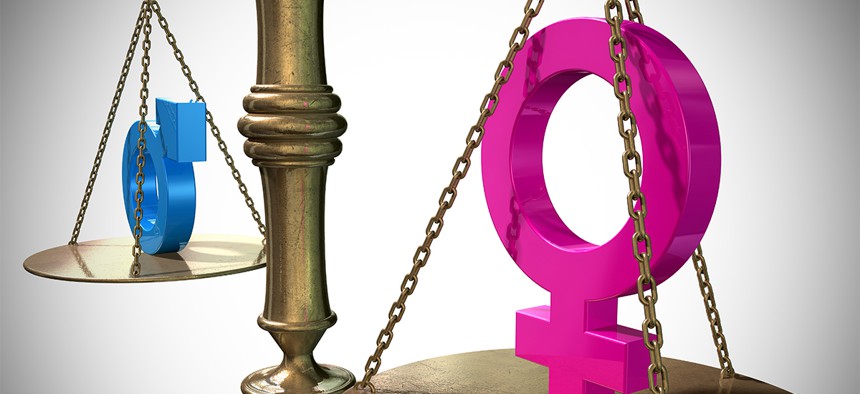
albund/Shutterstock.com
Men Are Both More and Less Intelligent Than Women
Surveys and reports are trying to settle an age-old debate.
At a recent cocktail reception in Manhattan, a friend sketched two bell curves, one much wider than the other. The narrower one placed slightly to the right. He explained to me they represented the distribution of male and female intelligence. He speculated that male intelligence was the wider curve—the implication being that woman may be a little smarter than men, on average, but most are just average. Men are more likely to be extremely smart or stupid.
I might have written him off as a left-tail case, but something about his hypothesis felt familiar. I have a STEM PhD, yet I am still often asked in both professional and social situations if I found statistics hard. Meanwhile, I’ve noticed if a man has any type of graduate degree where he took almost any kind of math class that sounds vaguely difficult, he’s presumed to be a math whiz. If he dresses weird and is socially awkward people assume he’s an outright genius. If I acted that way, people would just assume I was rude and frumpy, not necessarily brilliant.
It seems like many people agree women are just as smart—on average. A recent Pew survey claims a majority of Americans believe women display equal intelligence to men; women even have a slight edge on intellect perception. In the US, more women are in college. In 2012, 71% enrolled after high school, compared to just 61% of men. But when it comes to being exceptionally smart, funny , or talented, it feels like people still think that’s an exclusively male domain.
The male variability hypothesis, which seems to be driving what I’ve observed, claims men have a wider distribution of intellectual ability, which means there are more men in the upper tail of the intelligence distribution. It has been around since the 19th century, an idea buffered by the fact that most major scientific contributions in the 20th century came from men. But even 100 years ago, a fierce debate raged as to whether the difference reflected that men are indeed naturally smarter or if it was a byproduct of social conditioning, which includes access to education and society’s expectations. If it were social, you’d expect the distributions to look more similar today because attitudes and access to education have changed.
But even in these enlightened times, men still do display a wider range of intellectual ability. Using several different measures of intelligence including IQ and SAT scores, more men are found in the high and low tails, according to Josh Aronson, a professor of applied psychology at NYU. “Yes, the pattern that I see most often in the IQ literature, and the one that accords with my experience of nearly 40 years being near universities, is that you find more men at the extremes of performance, more among the mind-blowingly brilliant handful that you meet in a lifetime, and also more among the truly intellectually challenged handful. Within the extreme tails of the distribution, however, performance is generally equal between the sexes. But yes, men seem to have an edge at the extreme right end of of the bell curve.”
As to whether it is biological or environmental, “I think some of that is social,” he says, “but I would be surprised if it were all social.”
Researchers at Duke studied SAT scores of intellectually promising 7th graders (ages 12 to 13) over the last 30 years. The figure below took the ratio of boys to girls who scored in the top 1%, 0.5%, and 0.01% of the distribution in math scores (girls have a slight edge on the verbal SAT, but the differences are not nearly as large).
Up to the top 1%, boys and girls are nearly equal. But the higher into the tail you get, the bigger the differences emerge—and the boys dominate. In the 1980s, there were 13.5 boys for every girl in the top 0.01%, now there are only 3.8. The decline shows a large share of the gap was social conditioning, whether because of girls being told they could not be great at math or not being encouraged to take hard math classes. But a significant gap remains—some of if representing that we have further to go and some of it raising more uncomfortable questions about differences in innate ability.
Dave Lubinski, a psychology professor at Vanderbilt University, also studies the SAT scores of precocious 7th graders and tracks what happens to them in their careers. The oldest cohort is now 50 years old. He says once you narrow the population down to the 1 percenters in math, boys do score slightly higher. “But conditional on being in the 1% of math, the girls have better verbal skills.”
This suggests women may be less likely to be extreme math stars, but they display a more well-rounded intelligence. It’s hard to separate out what’s biological and environmental because intelligence reflects what you study and how intensely you pursue it. People are often drawn to what they are good at and what they have access to. Lubinski and his coauthors observed that women are more drawn to working with people and jobs that prize communication. Many talented women, for a number of reasons like discrimination or just their personal preferences, don’t end up as research scientists.
Perhaps this explains why a quantitative PhD does not buy me the same social allowances men seem to get. Lubinski stressed that men and women report similar levels of career satisfaction—though after speaking with him, part of me feels like I let my gender down by being a writer and not a micro-theorist.
( Image via albund / Shutterstock.com )






